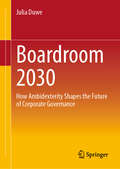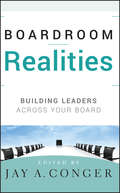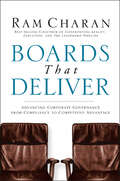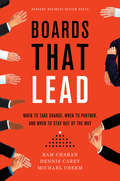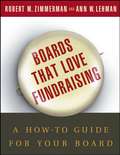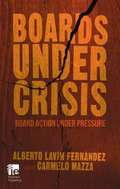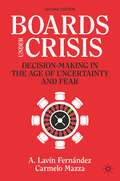- Table View
- List View
Board of Directors at Morgan Stanley Dean Witter (A)
by Jay W. Lorsch Ashley C. RobertsonExamines the resignation of Philip Purcell as chairman and CEO of Morgan Stanley as a result of poor performance and cultural problems, as well as his relationship to the board of directors.
Board of Directors at Morgan Stanley Dean Witter (B)
by Jay W. Lorsch Alexis ChernakSupplements the (A) case.
Board of Directors at the Coca-Cola Co.
by Rakesh Khurana Jay W. Lorsch Sonya SanchezProvides a history of the board of directors of the Coca-Cola Co. through 2003. Describes the evolution in the board's membership, practices, and structure and the role it played in the company's governance. Questions are raised about the relationship between the board and top management, especially how the board is carrying out its responsibilities in the 21st century.
Board of Directors: An Introductory Note
by Charles C.Y. Wang Kyle Thomas Selina JanHarvard Case Study
Board of Directors: An Introductory Note
by Charles C.Y. Wang Kyle Thomas Selina JanIndustry and Background Note
Board-Shareholder Dialogue: Policy Debate, Legal Constraints and Best Practices (International Corporate Law and Financial Market Regulation)
by Luca Enriques Giovanni StrampelliThis book provides corporate law scholars and students and practitioners at law firms, advisory services firms and asset managers with a comprehensive and rigorous analysis of the financial, managerial, policy and legal issues arising from a key feature of today's corporate governance environment, namely, the dialogue between shareholders and corporate boards. Bringing together top corporate law and corporate governance scholars from the world's leading academic institutions, the collection is characterized by a multi-dimensional approach that takes into account the particularities of some national legal systems and combines theoretical analysis with practical insights into various aspects of board-shareholder dialogue.
Boardroom 2030: How Ambidexterity Shapes the Future of Corporate Governance
by Julia DuweThe technological change is accelerating rapidly. New rules in global business ecosystems are disrupting established business models. Digital technologies like artificial intelligence challenge even the most proven products and value propositions. The corporate world is transforming at every level — and corporate governance must evolve alongside it. How can governance bodies drive and support a corporate transformation to secure the company&’s future? How can they stay ahead of disruptive change instead of just reacting to it? This book advocates for ambidexterity in supervisory boards — the ability to balance stability and innovation. It explores how today's governance bodies can evolve into tomorrow&’s pioneers by leveraging ambidexterity to oversee, guide, and challenge management. It shows how they can act as strategic sparring partners in shaping a competitive future while embracing an increasingly interconnected world.
Boardroom Battle Behind Bars: Gome Electrical Appliances Holdings -- A Corporate Governance Drama
by William C. Kirby Tracy Yuen MantyDespite widespread news of the incarceration of Gome Electronics' CEO, Huang Guangyu, Bain Capital felt they carefully undertook due diligence before making a significant investment in the company. The venture capital firm was confident that it and the current management could work together to revamp the fortunes of China's leading electronic retailer. However, it did not anticipate the power Huang had behind bars. As the majority shareholder, Huang has managed to manipulate shareholder meetings and current management decisions and structure. Was this typical of an investment in China or did Bain Capital just find itself in a unique situation? What can future managers learn from this situation about corporate governance and ethical rules of business in China?
Boardroom Change in Norway
by Jay W. Lorsch Melissa BartonIn 2003, the Norwegian Parliament amended the Public Limited Companies Act in order to achieve greater representation of women on corporate boards. According to the amendment, all state-owned companies and public limited companies were required to have at least 40% women on their boards. This case uses first-hand accounts from Norwegian directors to document the Norwegian business community's reaction to the quota, how Norwegian boards sought women directors, and the transferability of the quota law to other nations.
Boardroom Realities
by Jay A. CongerPraise for Boardroom Realities"Authored by a 'who's who' roster of governance experts, Boardroom Realities covers the latest trends in board leadership and performance as well as talent management for the board and the C-suite-all critical topics for any director serious about board service today."-Kenneth Daly, president and CEO, National Association of Corporate Directors"If leadership and effectiveness in the boardroom were important in a more benign environment, they're absolutely vital in today's tumultuous times. Boardroom Realities provides a modern and detailed road map to help steer chairmen, CEOs, and boards through these uncharted governance waters."-Peter Weinberg, partner, Perella Weinberg Partners"Jay Conger's Boardroom Realities offers a unique perspective on governance through leadership, rather than compliance, and should compel all directors to revisit the focus of board deliberations, especially at this time of unprecedented economic and financial turmoil."-Alison A. Winter, cofounder, WomenCorporateDirectors, and a corporate director for Nordstrom, Inc."Boardroom Realities is a very comprehensive compilation of useful insights on key issues that boards must deal with every day. It's an excellent resource for board members as well as members of management who must work together to ensure good governance on behalf of shareholders."-Ronald D. Sugar, chairman of the board and CEO, Northrop Grumman Corporation"Jay Conger has collected critical insights and the latest thinking on board leadership from many of today's foremost governance thinkers. Boardroom Realities is a must for your board and for any comprehensive corporate governance library."-Ralph D. Ward, publisher, Boardroom INSIDER, and author, The New Boardroom Leaders
Boards That Deliver
by Ram CharanFinally, a book that brings the vision of truly good governance down to earth. Ram Charan, expert in corporate governance and best-selling author, packs this book with useful tools and techniques to take boards and their companies to a higher level of performance. Charan puts his finger on a growing problem for boards: the disconnect between directors' efforts and their results. The added time and attention boards invest is not translating into better governance???that is, governance that adds value to the business.Boards That Deliver gets beyond the rhetoric of corporate governance reform. It captures the tried-and-true practices used by high-performance boards. In contrast to experts who base prescriptions on number-crunching exercises, Charan identifies the real problems that drain directors' time and suppress their best judgments???and explains clearly and succinctly how boards can solve those problems. These battle-tested solutions help boards achieve what rules and regulations alone cannot???to get succession right, refine a winning strategy, and design a rational CEO compensation package.Good governance requires leadership. Boards That Deliver is the no-nonsense guide for directors and CEOs who are rising to the leadership challenge to make their boards a competitive advantage.
Boards That Excel: Candid Insights and Practical Advice for Directors
by B. Joseph WhiteThis is a different kind of corporate governance book. With its vivid stories and conversational tone, Boards That Excel is like sitting down with an astute and experienced friend—one who’s passionate about what corporate and nonprofit boards can contribute to their organizations’ success when they set high aspirations, are clear on purpose, and do the right things in the right way. B. Joseph White, an experienced corporate and nonprofit director and a distinguished academic, argues that boards can enable organizations to do great things, but only when directors go well beyond their duty to oversee and monitor management. White offers a road map for governance success based on his experience with two of America’s most successful companies, one public and one private. He knows governance research and distills it to a handful of truly useful insights for boards and directors. He provides clear guidance on the essential work boards must do, and, drawing on behavioral research, he describes how they can ensure the boardroom is a place of good information, thoughtful evaluation, and wise decision making. The book reports on interviews with more than a dozen high-performance board chairs, CEOs, and directors, including Siebel Systems founder Tom Siebel, legendary real estate investor Sam Zell, former Harlem Globetrotters owner Mannie Jackson, GM board chairman and former Cummins chairman and CEO Tim Solso, and volunteer (University of Illinois, University of Michigan) and corporate (Hershey, Bob Evans) director Mary Kay Haben. All speak with unusual candor on what it takes for boards and directors to excel.
Boards That Lead
by Ram Charan Michael Useem Dennis CareyIs your firm's board creating value-or destroying it?Change is coming. Leadership at the top is being redefined as boards take a more active role in decisions that once belonged solely to the CEO. But for all the advantages of increased board engagement, it can create debilitating questions of authority and dangerous meddling in day-to-day operations. Directors need a new road map-for when to lead, when to partner, and when to stay out of the way.Boardroom veterans Ram Charan, Dennis Carey, and Michael Useem advocate this new governance model-a sharp departure from what has been demanded by governance activists, raters, and regulators-and reveal the emerging practices that are defining shared leadership of directors and executives. Based on personal interviews and the authors' broad and deep experience working with executives and directors from dozens of the world's largest firms, including Apple, Boeing, Ford, Infosys, and Lenovo, Boards That Lead tells the inside story behind the successes and pitfalls of this new leadership model and explains how to: Define the central idea of the company Ensure that the right CEO is in place and potential successors are identified Recruit directors who add value Root out board dysfunction Select a board leader who deftly bridges the divide between management and the board Set a high bar on ethics and riskWith a total of eighteen checklists that will transform board directors from monitors to leaders, Charan, Carey, and Useem provide a smart and practical guide for businesspeople everywhere-whether they occupy the boardroom or the C-suite.
Boards That Love Fundraising
by Robert M. Zimmerman Ann W. LehmanFrom the Book jacket: Boards That Love Fundraising is an easy-to-use workbook in which board members will find the information and skills they need to overcome the "fear factor" and become confident, successful fundraisers. Provides information on board structure and its impact on raising money, Outlines the concepts that will empower you to ask for money effectively and fearlessly, Describes the wide variety of methods nonprofits use to raise money and the board's role in each area, Shows how to recruit board members who can help with fundraising, Explores the vital issues of fundraising-planning, staffing, evaluation, and working with consultants. Using this indispensable tool, board members will learn how to transform their ideas about "begging for money" into opportunities to urge citizens to invest in their enterprise through philanthropic contributions. Boards That Love Fundraising provides a wealth of exercises to pave the way to successful board fundraising efforts. PRAISE FOR BOARDS THAT LOVE FUNDRAISING "Zimmerman and Lehman have more than two decades of hands-on experience helping board members know how to do their job. This workbook distills their knowledge into helpful and easy exercises and tips that everyone in the nonprofit can use to raise more money." -Kim Klein, publisher, Grassroots Fundraising Journal "The wisdom in Boards That Love Fundraising helped me and our board of directors deal with some of our most challenging issues. In this day and age, fundraising by board members is critical to the success of any nonprofit organization-including ours. Zimmerman and Lehman will help your board get there, too."-Janet Knipe, executive director, California Youth Correction
Boards That Make a Difference
by John CarverIn this revised and updated third edition, Carver continues to debunk the entrenched beliefs and habits that hobble boards and to replace them with his innovative approach to effective governance. This proven model offers an empowering and fundamental redesign of the board role and emphasizes values, vision, empowerment of both the board and staff, and strategic ability to lead leaders. Policy Governance gives board members and staff a new approach to board job design, board-staff relationships, the role of the chief executive, performance monitoring, and virtually every aspect of the board-management relationship. This latest edition has been updated and expanded to include explanatory diagrams that have been used by thousands of Carver's seminar participants. It also contains illustrative examples of Policy Governance model policies that have been created by real-world organizations. In addition, this third edition of Boards That Make a Difference includes a new chapter on model criticisms and the challenges of governance research.
Boards Under Crisis
by Alberto Lavín Fernández Carmelo MazzaAn innovative, research-based review of how boards make decisions during crises designed to offer insight and accessible theories for invested senior management facing crises situations. This book gathers recent and historical research on boardroom decision making from the field and business literature to review crises, TMT and decision making. "
Boards Under Crisis: Board action under pressure (IE Business Publishing)
by Carmelo Mazza Alberto Lavin FernandezAn innovative, research-based review of how boards make decisions during crises – designed to offer insight and accessible theories for invested senior management facing crises situations. This book gathers recent and historical research on boardroom decision making from the field and business literature to review crises, TMT and decision making.
Boards Under Crisis: Decision-Making in the Age of Uncertainty and Fear (IE Business Publishing)
by Carmelo Mazza A. Lavin FernandezCrises, in the past, have been cyclical events in economic history. However, we are currently experiencing an acceleration of these cycles with shorter time span in-between major events. In a period of 20 years, from 2001 to 2021, we have lived three global major crisis events: The Twin Tower Attack on September 11th, 2001, the Financial Crash in 2008, and the Covid-19 pandemic from 2020. In the first edition of this book, the authors explained the main decision-making patterns of behavior (i.e. short termism, centralization, and parochialism) that characterized the management processes of Boards of Directors during the financial crash. Now, in this revised and updated second edition, the authors explore the main commonalities and differences between decision making at the top during the previous financial crisis and during the most recent Covid 19 global pandemic, as well as during the inception of the war in Ukraine. In doing so they ask, is this a new crisis or just the “new normal” that businesses and organizations need to face after major catastrophic events? By first reassessing the very meaning of the word ‘crisis,’ the authors explore the relationship between frequent crises, emergency cabinets and socially widespread fear as determinants of a “new normal” rather than as the extraordinary state of our societies. In this sense, the authors identify more nuanced and updated consequences of short termism, centralization and parochialism that could shape the changes after the current crisis and the approach to next crisis to come
Boards and Shareholders in European Listed Companies
by Massimo Belcredi Guido FerrariniWith contributions by distinguished scholars from legal and financial backgrounds, this collection of essays analyses four main topics in the corporate governance of European listed firms: (i) board structure, composition and functioning and their interaction with ownership structure; (ii) board remuneration; (iii) shareholder activism and (iv) corporate governance disclosure based on the 'comply or explain' approach. The authors provide new comparative evidence and analyse its implications for the policy debate. They challenge the conventional wisdom that corporate governance in European firms was systematically dysfunctional. While proposals aimed at increasing disclosure and accountability are usually well-grounded, caution is suggested when bringing forward regulatory changes with respect to proposals targeting specific governance arrangements, especially in the fields of board composition and shareholder activism. They argue that the 'comply or explain' principle should be retained and further efforts should be exercised to enhance disclosure.
Boards of Directors in Disruptive Times: Improving Corporate Governance Effectiveness
by Jordi CanalsThe current business context of disruptive, accelerated change requires a new framework for understanding how boards of directors can best support their organizations. In this book, Professor Jordi Canals presents a new model of effective governance, positioning the board of directors as the steward of the firm's future development, and focusing on the notion of corporate purpose. Canals argues that boards of directors should focus on strategy and corporate transformation, CEO and senior management development and succession, the board and the firm's culture, the board as a team, the engagement of shareholders and critical stakeholders, and the firm's overall impact. Moreover, for boards to be effective, directors must develop new competencies. Drawing on well-grounded theory and international case studies, this book outlines a new, holistic model of boards of directors, offering a pathway to effective governance that will enhance companies' reputation and success.
Boat Trains: History, Development and Operation
by Martyn PringA study of the specialty train, including its history, development, and operation beginning at the end of the nineteenth century.In many ways this title, featuring the evolution of cross-channel boat trains and the many dedicated services responsible for moving international passengers to and from trans-Atlantic steamers, is an extension of luxury railway travel. But that’s not the full story as it encapsulates more than 125 years of independent and organised tourism development. At the end of the nineteenth century, faster and more stable twin-screw vessels replaced cross-channel paddlers resulting in a significant expansion in the numbers of day excursionists and short-stay visitors heading to Belgium, France and the Channel Islands. Continental Europe, as it had done since the end of the Napoleonic Wars beckoned, introducing ideas of modern-day mass tourism.Numerous liners bestriding the globe were British domiciled. Major ports became hives of commercial activity involving moving freight and mail, as well as transporting all manner of travellers. Not only was there intense competition for passenger traffic between the Old and New World and Britain’s imperial interests, greater numbers of well-heeled tourists headed off to warmer winter climes, and also experimented with the novel idea of using ocean steamers as hotels to visit an array of diverse destinations. Cruise tourism and the itinerary had arrived as ‘Ocean Special’ boat trains became essential components of railway and port procedures.Whilst some railway operations were dedicated to emigrant traffic, continental and ocean liner boat trains were also synonymous with the most glamorous travel services ever choreographed by shipping lines and railway companies working closely in tandem. This well illustrated book explores the many functions of boat train travel.“This book should appeal to the rail fan, the ship enthusiast, the connoisseur of travel posters and those interested in the business of transportation. I know of nowhere else one can find so much information on boat train operation in one book. . . . Well worth a read by anyone interested in the interconnectivity of different means of public transportation.” —Charles H. Bogart, Steamship Historical Society of America
Bob Beall at the Cystic Fibrosis Foundation
by Robert Steven Kaplan Sophie HoodBob Beall is the Chief Executive Officer of the Cystic Fibrosis Foundation ("CFF"). CFF is an extremely successful organization, but Beall has to determine how to manage the organization through the financial crisis of 2008/2009. In this situation, donations are likely to decline, investment surplus has declined and biotech partners are challenged to finance joint projects as well as their own operations. Beall is striving to find a cure for cystic fibrosis while also determining what priorities he must emphasize and what trade-off decisions he must make in managing through the current period. He is preparing for a meeting with his board of trustees where he plans to discuss the current situation and the key decisions the organization needs to make.
Bob Fifer
by David A. Thomas Doug CohenExplores the life and concerns of Bob Fifer, HBS class of 1979 and CEO of Kaiser Associates. Explores the many influences on Bob's development and his subsequent career choices. It is written as a biography with extensive quotes from interviews with Bob. He describes the role of his upbringing and Jewish ethnicity in the formation of his early self-concept. Highlights the career-related choices he makes, including college at Harvard, attending business school, and entering consulting. After years of success and driven workaholic behavior, Bob experiences disillusionment and personal tragedy.
Bob Galvin and Motorola, Inc. (A)
by Mary Gentile Todd D. JickDescribes the changing environment faced by Motorola in the 1980s and the recognition by its CEO, Bob Galvin, that "change is needed." Also describes a major challenge set forth by Galvin to the organization to do something to prepare for the future. The challenge is somewhat ambiguous, however, and the reaction is mixed.
Bob Kleberg and the King Ranch: A Worldwide Sea of Grass
by John Cypher&“Combines a biography of Kleberg . . . with the story of the postwar boom years that changed the King Ranch . . . into an international corporate agribusiness.&” —Houston Chronicle Ranching on the vast scale that Texas is famous for actually happened at King Ranch, a sea of grass that ultimately spread its pastures to countries around the globe under the fifty-year leadership of Bob Kleberg. This absorbing biography, written by Kleberg's top assistant of many years, captures both the life of the man and the spirit of the kingdom he ruled, offering a rare, insider's view of life on a fabled Texas ranch. John Cypher spent forty years (1948–1988) on King Ranch. In these pages, he melds highlights of Kleberg&’s life with memories of his own experiences as the &“right hand&” who implemented many of Kleberg's grand designs. In a lively story laced with fascinating anecdotes, Cypher both recounts his worldwide travels with Kleberg as the ranch expanded its holdings around the world, and describes timeless, traditional tasks such as roundup at the home ranch in Kingsville. Chronicling Kleberg&’s accomplishments as well as his legendary lifestyle, which included friendships not merely with the rich and famous but also with Queen Elizabeth, who shared his love of horse racing, this book is essential reading for anyone interested in ranching and one of its most famous practitioners. &“Cypher[&‘s] easy conversational style makes life on a working ranch, the care and feeding of visiting celebrities and the field of international agribusiness both understandable and entertaining.&” —San Antonio Express-News &“Probably the best of what will ever be known of the inner Bob Kleberg.&” —East Texas Historical Journal


